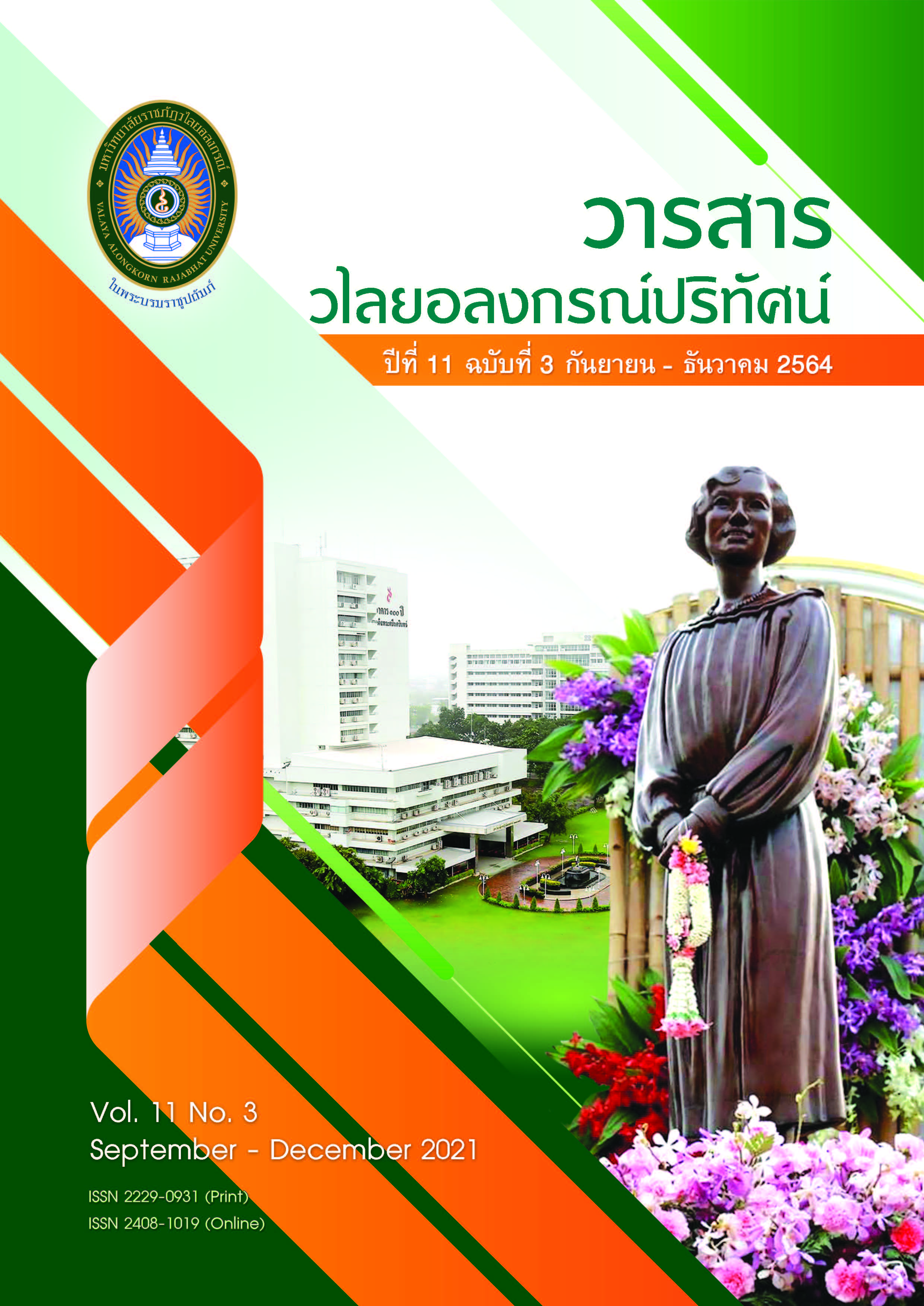แนวทางการจัดการเพื่อเพิ่มความสามารถในการแข่งขันของผู้ประกอบการอุตสาหกรรมเครื่องนุ่งห่มไทย
คำสำคัญ:
การจัดการ, ความสามารถในการแข่งขัน, ผู้ประกอบการ, อุตสาหกรรมเครื่องนุ่งห่มบทคัดย่อ
การศึกษาครั้งนี้มีรูปแบบการวิจัยแบบผสมผสาน (Mix method) มีวัตถุประสงค์เพื่อ 1) ศึกษาสภาพ และปัญหาความสามารถในการแข่งขันของผู้ประกอบการอุตสาหกรรมเครื่องนุ่งห่มไทย 2) เปรียบเทียบความสามารถในการแข่งขันของผู้ประกอบการอุตสาหกรรมเครื่องนุ่งห่มไทย จำแนกตามปัจจัยส่วนบุคคลและปัจจัยลักษณะธุรกิจ 3) ศึกษาปัจจัยการจัดการที่ส่งผลต่อความสามารถในการแข่งขันของผู้ประกอบการอุตสาหกรรมเครื่องนุ่งห่มไทย และ 4) วิเคราะห์และนำเสนอแนวทางการจัดการเพื่อเพิ่มความสามารถในการแข่งขันของผู้ประกอบการอุตสาหกรรมเครื่องนุ่งห่มไทย การศึกษาครั้งนี้เป็นการวิจัยเชิงสำรวจ กลุ่มตัวอย่างที่ใช้ในการศึกษา ได้แก่ ตัวแทนของผู้ประกอบการในธุรกิจเครื่องนุ่งห่ม จำนวน 327 คน และผู้เชี่ยวชาญเกี่ยวกับอุตสาหกรรมเครื่องนุ่งห่มจำนวนกลุ่มตัวอย่าง 17 คน เครื่องมือที่ใช้ในการศึกษา 1) แบบสอบถาม โดยมีค่าดัชนี IOC เท่ากับ 0.86 และค่าสัมประสิทธิ์แอลฟา เท่ากับ 0.99 และ 2) แบบสัมภาษณ์เชิงลึกเป็นเครื่องมือ วิเคราะห์แบบสัมภาษณ์ โดยวิธีการวิเคราะห์เนื้อหา วิเคราะห์ความสามารถในการแข่งขันของผู้ประกอบการอุตสาหกรรมเครื่องนุ่งห่มไทยจำแนกตามปัจจัยส่วนบุคคลและปัจจัยคุณลักษณะธุรกิจ โดยใช้วิธีการเปรียบเทียบค่าเฉลี่ยของกลุ่มตัวอย่าง 2 กลุ่ม (t-test) การวิเคราะห์ความแปรปรวนแบบทางเดียว (ANOVA) และวิเคราะห์ความสัมพันธ์ระหว่างปัจจัย โดยใช้การวิเคราะห์ความสัมพันธ์ระหว่างตัวแปรโดยการวิเคราะห์การถดถอยเชิงพหุ
ผลการศึกษาพบว่า ปัจจัยด้านการจัดการของผู้ประกอบการอุตสาหกรรมเครื่องนุ่งห่มไทย ภาพรวม พบว่า อยู่ในระดับมาก สามารถเรียงลำดับค่าเฉลี่ยมากไปหาน้อยได้ดังต่อไปนี้ ด้านการวางแผน รองลงมา ได้แก่ ด้านนวัตกรรม ด้านทรัพยากรบุคคล ด้านการผลิต และด้านการตลาด ตามลำดับ ความสามารถในการแข่งขันของผู้ประกอบการอุตสาหกรรมเครื่องนุ่งห่มไทย ภาพรวม พบว่า อยู่ในระดับมาก สามารถเรียงลำดับค่าเฉลี่ยมากไปหาน้อยได้ดังต่อไปนี้ การมุ่งตลาดเจาะจงเฉพาะส่วน รองลงมาได้แก่ การสร้างความแตกต่าง และการความได้เปรียบทางด้านต้นทุน ตามลำดับผู้ประกอบการอุตสาหกรรมเครื่องนุ่งห่มไทยที่มีรูปแบบของธุรกิจ ทุนจดทะเบียน ระยะเวลา ในการดำเนินกิจการ และสัดส่วนผู้ถือหุ้นแตกต่างกันมีความสามารถในการแข่งขันแตกต่างกัน อย่างมีนัยสำคัญทางสถิติ และปัจจัยที่มีอิทธิพลต่อความสามารถในการแข่งขันของผู้ประกอบการอุตสาหกรรมเครื่องนุ่งห่มไทย ได้แก่ ด้านการวางแผน ด้านการผลิต ด้านทรัพยากรบุคคล ด้านนวัตกรรม ด้านการตลาด โดยมีนัยสำคัญทางสถิติ มีอำนาจในการพยากรณ์ร้อยละ 61.60 (R2 = 0.616) แนวทางการจัดการเพื่อเพิ่มความสามารถในการแข่งขันของผู้ประกอบการอุตสาหกรรมเครื่องนุ่งห่มไทย ได้แก่ แนวทางที่ 1 พัฒนาความรู้ด้านการบริหารจัดการ และการลดต้นทุนของผู้ประกอบการ แนวทางที่ 2 ยกระดับจากการเป็นผู้รับจ้างผลิตสินค้าตามแบบที่ลูกค้ากำหนด เป็นการผลิตที่สามารถเพิ่มมูลค่าสินค้าได้ด้วยการดีไซน์มีการพัฒนารูปแบบสินค้าและเอาสินค้าเหล่านั้นไปเสนอขายให้ลูกค้า หรือการผลิตภายใต้ แบรนด์ของตัวเอง แนวทางที่ 3 สนับสนุนการวิจัยและพัฒนา (Research & Development) เพื่อสร้างนวัตกรรม และแนวทางที่ 4 การรวมกลุ่มเป็น Cluster ตลอดสายโซ่อุปทาน การสร้างตราสินค้า การพัฒนาเทคโนโลยีการผลิต การใช้นวัตกรรมเพื่อสร้างมูลค่าเพิ่ม การสร้างบุคลากรที่มีคุณภาพและเพียงพอกับความต้องการของอุตสาหกรรม
เอกสารอ้างอิง
ก้องเกียรติ บูรณศรี. (2554). แบบจำลองความสัมพันธ์เชิงสาเหตุระหว่างความเป็นผู้ประกอบการขององค์การสภาพแวดล้อมทางธุรกิจ และผลการดำเนินงานของสถานประกอบการอุตสาหกรรมการผลิต. U Academic Review. 9 (2), 146-158.
กรมโรงงานอุตสาหกรรม, ศูนย์ข้อมูลและดิจิทัลอุตสาหกรรม สถาบันพัฒนาอุตสาหกรรมสิ่งทอ. (2563). ข้อมูลสถิติโรงงานในอุตสาหกรรมสิ่งทอและเครื่องนุ่งห่ม. สถาบันพัฒนาอุตสาหกรรมสิ่งทอ.
ชูชีพ เอื้อการณ์. (2557). แนวทางการส่งเสริมและพัฒนาอุตสาหกรรมสิ่งทอไทยเพื่อการแข่งขันระดับโลก. วิทยานิพนธ์รัฐประศาสนศาสตรดุษฎีบัณฑิต มหาวิทยาลัยราชภัฏวไลยอลงกรณ์ ในพระบรมราชูปถัมภ์ จังหวัดปทุมธานี.
ฐานวัฒน์ ฉัตรวิริยานนท์. (2563). การพัฒนาขีดความสามารถการแข่งขันของผู้ประกอบการ
เครื่องนุ่งห่มไทยอย่างยั่งยืน. ปรัชญาดุษฎีบัณฑิต สาขาการบริหารการพัฒนา มหาวิทยาลัยราชภัฏสวนสุนันทา.
ไตรถิกา พิชิตเดช และคณะ. (2557). รายงานการวิจัยการสังเคราะห์งานวิจัยด้านอุตสาหกรรมเครื่องนุ่งห่ม. กรุงเทพฯ: มหาวิทยาลัยเทคโนโลยีราชมงคลพระนคร.
ณัฐกานต์ พวงไพบูลย์. (2562). เทคโนโลยีการผลิตสำหรับอุตสาหกรรมสิ่งทอและเครื่องนุ่งห่มไทย. คณะเทคโนโลยีอุตสาหกรรม มหาวิทยาลัยราชภัฏเทพสตรี.
ธนพล สุขเวสโก. (2561). แนวทางการจัดการอุตสาหกรรมเสื้อผ้าสำเร็จรูปสู่ความยั่งยืน.บริหารธุรกิจดุษฎีบัณฑิต คณะบริหารธุรกิจ มหาวิทยาลัยเทคโนโลยีพระจอมเกล้าพระนครเหนือ.
มานพ ชุ่มอุ่น. (2554). รายงานวิจัย เรื่อง การพัฒนากระบวนการจัดการทางการตลาดในผลิตภัณฑ์จากผ้าฝ้ายทอมือ กรณีศึกษา: กลุ่มผ้าฝ้ายทอมือบ้านดอนหลวง ตำบลแม่แรง อำเภอป่าซาง จังหวัดลำพูน. เชียงใหม่: มหาวิทยาลัยราชภัฎเชียงใหม่.
ศูนย์ข้อมูลและดิจิทัลอุตสาหกรรม สถาบันพัฒนาอุตสาหกรรมสิ่งทอ. (2564). อุตสาหกรรมสิ่งทอกับ BCG ECONOMY. โครงการศูนย์สารสนเทศอัจฉริยะอุตสาหกรรมแฟชั่น ปี 2564. กรุงเทพฯ: สถาบันพัฒนาอุตสาหกรรมสิ่งทอ.
ศูนย์เทคโนโลยีสารสนเทศและการสื่อสาร สำนักงานปลัดกระทรวงพาณิชย์. (2561). แผนพัฒนาดิจิทัลเพื่อเศรษฐกิจการพาณิชย์ พ.ศ. 2560-2564. กรุงเทพฯ: กระทรวงพาณิชย์.
สถาบันพัฒนาสิ่งทอ และสำนักงานเศรษฐกิจอุตสาหกรรม. (2562). ภาวะเศรษฐกิจอุตสาหกรรม ธันวาคม 2562. กรุงเทพฯ: สถาบันพัฒนาสิ่งทอ และสำนักงานเศรษฐกิจอุตสาหกรรม.
สถาบันพัฒนาอุตสาหกรรมสิ่งทอ. (2563). จำนวนโรงงานในอุตสาหกรรมเครื่องนุ่งห่ม ณ ธันวาคม 2562. กรมโรงงานอุตสาหกรรม, ศูนย์ข้อมูลและดิจิทัลอุตสาหกรรม (ระบบออนไลน์).
สำนักงานคณะกรรมการพัฒนาการเศรษฐกิจและสังคมแห่งชาติ สำนักนายกรัฐมนตรี. (2560). แผนพัฒนาเศรษฐกิจและสังคมแห่งชาติ ฉบับที่ 12 2560-2564. กรุงเทพฯ: สำนักนายกรัฐมนตรี.
สำนักส่งเสริมวิสาหกิจขนาดกลางและขนาดย่อม. (2561). การจัดอันดับความน่าเชื่อถือของ SME ด้วยข้อมูลด้านที่ไม่ใช่การเงิน (non-financial data) ภายใต้งานจัดทำแผนปฏิบัติการส่งเสริมวิสาหกิจขนาดกลางและขนาดย่อม. กรุงเทพฯ: สำนักส่งเสริมวิสาหกิจ ขนาดกลางและขนาดย่อม.
อนุพงษ์ อินฟ้าแสง. (2560). ศักยภาพการปรับตัวเข้าสู่ตลาดโลกของอุตสาหกรรมสิ่งทอและเครื่องนุ่มห่มไทย. วารสารวิชาการมหาวิทยาลัยธนบุรี. 11(26). กันยายน – ธันวาคม 2560.
Brzozowski. (2011). Viewpoint: Measuring the Well-being of the Poor with Income or Consumption: A Canadian Perspective. European University Institute - Economics Department (ECO); Institute for Fiscal Studies.
Chen, H. (2003). Relationships of Teamwork Skills with Performance Appraisals and Salary Information in a Taiwanese. High-performance Work Organization (China).
Kiyosaki. (2010). Rich dad's cash flow quadrant: guide to financial freedom. Scottsdale, Ariz.: Plata, 2012.
Kotler, P. (2012). Marketing Management. Pearson Education. New Jersey: Prentice Hall.
ดาวน์โหลด
เผยแพร่แล้ว
รูปแบบการอ้างอิง
ฉบับ
ประเภทบทความ
สัญญาอนุญาต
ลิขสิทธิ์ (c) 2021 พลกฤต โสลาพากุล

อนุญาตภายใต้เงื่อนไข Creative Commons Attribution-NonCommercial-NoDerivatives 4.0 International License.
ข้อความที่ปรากฏในบทความแต่ละเรื่องในวารสารวไลยอลงกรณ์ปริทัศน์ เป็นความคิดเห็นของผู้นิพนธ์แต่ละท่าน มิใช่เป็นทัศนะและมิใช่ความรับผิดชอบของกองบรรณาธิการจัดทำวารสาร และ
มหาวิทยาลัยราชภัฏวไลยอลงกรณ์ ในพระบรมราชูปถัมภ์


